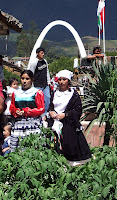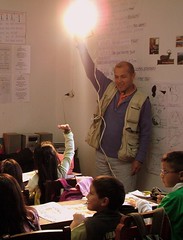


Think you've seen everything in Chachapoyas?
Plaza de Armas de Chachapoyas, Square of Chachapoyas
It has a bronze Republican style fountain, surrounded by beautiful colonial houses with traditional balconies, highlighting the city hall and the home of famous city son, Toríbio Rodriguez de Mendoza.
Complejo Arqueológico de Ollape, Ollape Archaeological Complex
Ancient village constructed from circular buildings, with diamond designs and niches in the walls. Made of limestone and mud mortar. The surrounding environment is of agricultural crops and natural vegetation.
Activities: Trekking, hiking, observing flora, photography and film, visits.
Iglesia de La Buena Muerte, Church of The Good Death
Previously named St. Lazarus, because it was part of the religious complex of the Vincentians.
Laguna de los Cóndores, Lake of the Condors, Leimebamba
Located 93 miles south of Chachapoyas (3 hours and 30 minutes by car). From Leymebamba it's 45 km to the lake (12 hours on foot or by mule). On the banks of th e lagoon more than 200 mummies were found decorated with ancient designs in good condition, and 3000 objects possibly belonging to the Inca and the Chachapoya.
Activities: Hiking, camping, wildlife observation, horseback riding, photography and film and guided tours.
Museo de Sitio de Leymebamba, Leymebamba Site Museum, Leimebamba
Located at Avenida Austria. Can be visited from Monday to Sunday between 9:30 am and 16:30 pm. Leymebamba City is 93 miles south of Chachapoyas (3 hours 30 minutes by car) and from Leymebamba it's a 10 km walk to the museum. The modern museum features mummies and objects found at the Lake of the Condors, as well as textiles, ceramics and
weapons found in the area.
Activities: Taking photographs and filming.
Bosque de Palmera de Ocol, Ocol palm forest, Chachapoyas
Located in the town of San Jose de Ocol, 10 km from the district of Molino Pampa. The area where the palms are covers about 80 km2 and the palms are on average 16m tall.
Complejo Arqueológico La Congona, La Congona Archeological Complex, Leymebamba
Built of stone and constructed symmetrically with only mud mortar. External decoration is the typical regional diamond design with quadrangular interior niches.
Activities: Hiking, camping, observation of flora, photography and film, visits.
Complejo Arqueológico Purun Llacta, Purun Llacta Archeological Complex, Cheto
From Cheto district it's a hike of 12 km (2 hours) Its buildings are of stone constructed with only mud mortar and geometric decorations on the walls, covering approximately 65 hectares.
Activities: Trekking, hiking, wildlife watching, observing flora, taking photographs and filming.
Complejo Arqueológico de Olán, Olan Archaeological Complex, San Pedro de Utac
From the village of San Pedro de UTAC, walking for about 30 minutes, you can find a town of 500 dwellings with the circular design of the Chachapoya culture. It's considered the most artistic town center because of its impressive decorations.
Activities: Hiking, observation of flora, photography and film, visits.
Complejo Arqueológico de Macro, Macro Archaeological Complex, Chachapoyas
Located 37 km. from the city of Chachapoyas (2 hours) and then 8 kms walk (1 hour approx.).
Macro is situated on a steep slope, it is formed by five platforms that support huts, and towers, built with stones and mud mortar. An estimated 100 people once lived here.
Activities: Hiking, camping, wildlife observation, photography and film, visits.
Valle de los Chilchos, Chilchos Valley, Leymebamba
Located 10 hrs. from Leymebamba. It is a virtually unexplored area in which cloudforest still hides the remains of the chiefdom of Chilchos. A small sample of their existence can be found at the mausoleums of El Dorado.
Complejo Arqueológico Sholón, Sholón Archeological Complex, Colcamar
Located northwest of the town of Colcamar (1 hour and 20 minutes walking). The sarcophagi are embedded in painted rocks at Sholón. Beautiful semicircular mausoleums nearly 10 m. high, some still hold mummies and local textiles designs.
Pueblo de los Muertos, Lamud
From Lamud it's a short trek of 18 km (3 hours). It is a place dedicated to worship of the dead, of their highest leaders, through statues and decorated funerary sarcophagi, both square and round, based within an area of one hectare. This culture is part of the pre-Inca Chachapoya, dating tobetween 1,100 to 1,350 AD
Activities: Trekking, hiking, wildlife observation, photography and film, visits.
Zona arqueológica de Yálape, Archaeological Zone of Yalape, Levanto
Located 21 km south of the city of Chachapoyas (40 minutes by car) at a height of 2700 meters above sea level. This archaeological complex of the Chachapoya dates from 1100 to 1300 AD. It is estimated that it covers an area of 4 hectares and features the classic circular buildings decorated with high relief friezes in the form of lozenges and zigzags. This place can be a good site for hiking, camping, hiking, observing flora, taking photographs and filming.
Río Utcubamba, Leymembamba
Best site is found near Leymebamba, 90 km from Chachapoyas. The already white water of the Río Utcubamba is livened up by outflow from several hydroelectric plants that provide electricity to most of the Amazon Region. You can also see the barrel of the Rio.
Diablo Huasi, Chachapoyas
In this area, consisting of terraces carved on the mountain and skin ichu, as well as scattered ruins and remains of the Chachapoya. In this almost inaccessible place, the Chachapoya built grand buildings, composed of different floors and windows, decorated and painted red. To this place the Chachapoyas transferred their dead for eternal rest.
Valle de Alto Imaza, High Imaza Valley, Jumbilla
Traveling to the High Imaza takes an average of five hours, covering the route from Chachapoyas, via Pedro Ruiz, Pomacochas, and then Jumbilla to enter a stunning Andean valley.
In Jumbilla, 15 waterfalls twice the height of the Eiffel Tower in Paris have recently been discovered. The High Imaza Valley is an ideal place to have contact with nature, and a lodge is being constructed. You can take walks, hike, observe flora, take photographs and film.
Iglesia de La Jalca, Church of La Jalca, Leymebamba
First Christian church in the north east of Peru, built of stones with diamond figures showing the syncretism which occurred in early colonial times. This church is located in the town of La Jalca (former capital of Chachapoyas) 83 km south of Chachapoyas.
Fortaleza de Kuélap, Kuélap Fortress, Luya
Thought to be the second most impressive archaeological site in all of Peru (second only to MachuPicchu). Located 72 km southwest of the city of Chachapoyas (3 hours and 30
minutes by minibus). Impressively massive stone fortress built by the Chachapoya culture. Composed of checkpoints, a turret and 3 narrow entrance tunnels.
Activities: Hiking, camping, hiking, wildlife observation, photography and film, guided tours.
La Gran Vilaya, Luya
Located in the district of Pizuquia. You can trek there from the towns of Yumal, or Choctamal, or take a horse trail along the Inca paths (4 hours). This archaeological zone is characterized by hidden housing developments, with thousands of buildings of various kinds, and also platform structured. Virtually unexplored.
Activities: Hiking, camping, hiking, wildlife observation, photography and film, visits.
Huaylla Belén, Huaylla Bethlehem, Lamud
Located 3 hours from the city of Lamud. It is a momentously pretty valley surrounded by a winding, beautiful river that flows from all around Bethlehem to the valley (the Huaylla), finally disappearing beneath a huge mountain.
Activities: Hiking, wildlife observation, photography and film, visits to local artisans
Mausoleos de Revash, Mausoleums of Revash, Leymembamba
En route to Leymebamba, from the village of Santo Tomas its a 1 hour walk. It is a center consisting of rectangular funeral buildings (Chullpas) of 1, 2 or 3 floors. Some of the chullpas have pitch roofs made up of plastered and painted logs.
Sarcófagos de Karajía, Sarcophagis of Karajía, Luya
Located 48 km northeast of Chachapoyas (2 hours by car and then a 50 minute walk). The sarcophagi at Karajía were discovered at the edge of an abyss. They were created by the Chachapoya, who established their funeral sites in the most unexpected places. They are thousand year old pre-Inca tombs molded in clay and decorated with geometric motifs,
probably serving to bury the native leaders.
Activities: Trekking, hiking, observing flora and landscapes, taking photographs and filming.
Distrito de Tingo, Tingo District, Luya
The district of Tingo was founded on January 2, 1875 and has a population of more than 1,000. Its capital is the town of Tingo. This district offers several attractive locations, the best known being the fortress of Kuélap.
Lamud, Luya
Capital of the Province of Luya. The town festivities are celebrated on 14 September, the feast of the Lord Gualamita.
Cavernas de Quiojta, Quiojta Caverns, Lamud
Located 45 minutes from the city of Lamud. You enter through a cave of about 5 meters in diameter. It's a walk of about 500 meters. Within you can see impressive stalactites and stalagmites.
Activities: trekking, hiking, wildlife observation, photography and film, guided tours.
Petroglifos de la Pitaya, Petroglyphs of Pitaya, Luya
From Tingo travel north to Caclic, then continue up the road until you pass the petroglyphs (1 hour and 30 minutes.) These petroglyphs are in high relief covering an area of 100m2. Around 3,000 years old, there are a total of 30 representations of flora, fauna and hunting scenes.
Activities: taking photographs and filming.
Laguna de Pomacochas, Pomacochas Lagoon, Bongará
Located 1 km from Pomacochas town (15 min walk). With an area of 12 km2, its waters have a wonderful blue-green color and along its banks are cattails, tendrils and vines.
Activities: Hiking, canoeing, boating, crafts, and purchase of dairy products, hiking, wildlife observation, fishing, photography and
filming.
Catarata de Gocta, Gocta Waterfall, Bongará
From the town of Cocachimba to 4 hours walking. Known locally as La Chorrera. It is the third highest waterfall in the world at 771 meters, discovered in 2005.
Levanto, Chachapoyas
Town located on the mountain overlooking Chachapoyas city, near the ruins of Yalape. Walking, up from Chachapoyas, in the Inca Trail, takes about 4-5; or only 2 hours walking in the other direction towards Chachapoyas.
El Mirador del Huancas, Chachapoyas
You can walk from the town jail of Huancas, near the Canyon Viewpoint, 2 hours down through the canyon to the town of Pedro Ruiz.
Pozo de Yanayacu, Yanayacu Well, Chachapoyas
Located in the Cerro Luya Urco district of Chachapoyas, 1 km from the Plaza de Armas (15 min walk). Built by Santo Toribio de Mogrovejo who left engraved on the well a stone figure of a mitre, a staff and the year of construction. Its known locally as a meeting place for couples and a symbol of love.
Sarcófagos de Ayachaqui, Sarcophagi of Ayachaqui, Utcubamba
The sarcophagi, in human form, are more than two meters tall and are planted vertically, like a statue, perched on rocky hills covered with vegetation at more than 2,400 meters above sea level.
Still think you've seen everything?
Why not take this list to one of the many tour outfits lining the
Plaza de Armas, and ask about guided treks, camping, or group trips to
some of these sites.
Believe us, once you start asking about hidden archaeological sites in
Amazonas, there are more than even this list covers.
Images of these sites: http://www.mediafire.com/?bx2xzilybze




No hay comentarios.:
Publicar un comentario